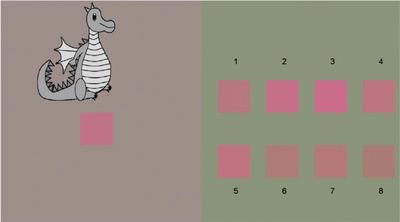Our official English website, www.x-mol.net, welcomes your feedback! (Note: you will need to create a separate account there.)
Developmental changes in colour constancy in a naturalistic object selection task
Developmental Science ( IF 4.939 ) Pub Date : 2022-08-09 , DOI: 10.1111/desc.13306 Rebecca Wedge-Roberts 1 , Stacey Aston 1 , Ulrik Beierholm 1 , Robert Kentridge 1, 2 , Anya Hurlbert 3 , Marko Nardini 1 , Maria Olkkonen 1, 4
Developmental Science ( IF 4.939 ) Pub Date : 2022-08-09 , DOI: 10.1111/desc.13306 Rebecca Wedge-Roberts 1 , Stacey Aston 1 , Ulrik Beierholm 1 , Robert Kentridge 1, 2 , Anya Hurlbert 3 , Marko Nardini 1 , Maria Olkkonen 1, 4
Affiliation

|
When the illumination falling on a surface change, so does the reflected light. Despite this, adult observers are good at perceiving surfaces as relatively unchanging—an ability termed colour constancy. Very few studies have investigated colour constancy in infants, and even fewer in children. Here we asked whether there is a difference in colour constancy between children and adults; what the developmental trajectory is between six and 11 years; and whether the pattern of constancy across illuminations and reflectances differs between adults and children. To this end, we developed a novel, child-friendly computer-based object selection task. In this, observers saw a dragon's favourite sweet under a neutral illumination and picked the matching sweet from an array of eight seen under a different illumination (blue, yellow, red, or green). This set contained a reflectance match (colour constant; perfect performance) and a tristimulus match (colour inconstant). We ran two experiments, with two-dimensional scenes in one and three-dimensional renderings in the other. Twenty-six adults and 33 children took part in the first experiment; 26 adults and 40 children took part in the second. Children performed better than adults on this task, and their performance decreased with age in both experiments. We found differences across illuminations and sweets, but a similar pattern across both age groups. This unexpected finding might reflect a real decrease in colour constancy from childhood to adulthood, explained by developmental changes in the perceptual and cognitive mechanisms underpinning colour constancy, or differences in task strategies between children and adults.
中文翻译:

自然对象选择任务中颜色恒常性的发展变化
当落在表面上的照明发生变化时,反射光也会发生变化。尽管如此,成年观察者善于将表面视为相对不变的——一种称为颜色恒常性的能力。很少有研究调查婴儿的颜色恒常性,对儿童的研究更少。在这里,我们询问儿童和成人之间的颜色恒常性是否存在差异;6 到 11 岁之间的发展轨迹是什么;以及成人和儿童之间照明和反射率的恒定模式是否不同。为此,我们开发了一种新颖的、对儿童友好的基于计算机的对象选择任务。在这种情况下,观察者在中性照明下看到龙最喜欢的糖果,并从在不同照明(蓝色、黄色、红色或绿色)下看到的八种糖果中挑选出匹配的糖果。该组包含反射匹配(颜色恒定;完美性能)和三色匹配(颜色不稳定)。我们进行了两个实验,一个是二维场景,另一个是三维渲染。26 名成人和 33 名儿童参加了第一个实验;第二组有 26 名成人和 40 名儿童参加。儿童在这项任务上的表现优于成人,并且在两个实验中他们的表现都随着年龄的增长而下降。我们发现照明和糖果之间存在差异,但两个年龄组的模式相似。这一意想不到的发现可能反映了从童年到成年颜色恒常性的真正下降,这可以通过支持颜色恒常性的知觉和认知机制的发展变化,或儿童和成人之间任务策略的差异来解释。
更新日期:2022-08-09
中文翻译:

自然对象选择任务中颜色恒常性的发展变化
当落在表面上的照明发生变化时,反射光也会发生变化。尽管如此,成年观察者善于将表面视为相对不变的——一种称为颜色恒常性的能力。很少有研究调查婴儿的颜色恒常性,对儿童的研究更少。在这里,我们询问儿童和成人之间的颜色恒常性是否存在差异;6 到 11 岁之间的发展轨迹是什么;以及成人和儿童之间照明和反射率的恒定模式是否不同。为此,我们开发了一种新颖的、对儿童友好的基于计算机的对象选择任务。在这种情况下,观察者在中性照明下看到龙最喜欢的糖果,并从在不同照明(蓝色、黄色、红色或绿色)下看到的八种糖果中挑选出匹配的糖果。该组包含反射匹配(颜色恒定;完美性能)和三色匹配(颜色不稳定)。我们进行了两个实验,一个是二维场景,另一个是三维渲染。26 名成人和 33 名儿童参加了第一个实验;第二组有 26 名成人和 40 名儿童参加。儿童在这项任务上的表现优于成人,并且在两个实验中他们的表现都随着年龄的增长而下降。我们发现照明和糖果之间存在差异,但两个年龄组的模式相似。这一意想不到的发现可能反映了从童年到成年颜色恒常性的真正下降,这可以通过支持颜色恒常性的知觉和认知机制的发展变化,或儿童和成人之间任务策略的差异来解释。



























 京公网安备 11010802027423号
京公网安备 11010802027423号